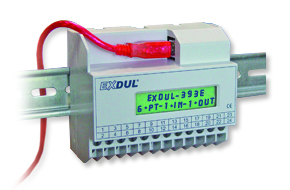USB module for temperature sensors PT100 PT1000

EXDUL-393E100
- 6 temperature PT100 PT1000 temperature range -200 ... 800°C resolution typ. 0,03°C overvoltage protection +/-45V
- 1 optocoupler input
- 1 counter occupies one input
- 1 optocoupler output
- Programmable logic
- Module initiated message
- Watch dog
- LCD display
- 100Base-T Ethernet interface
EDV-Nummer: A-382320
Temperature measurement PT100 PT1000
The EXDUL-393E100 USB temperature measurement module has 6 temperature measurement units for the PT100 and PT1000 temperature sensors, each with its own power source and measurement inputs. The connection is made in the 3-wire circuit. This enables the module to determine and compensate for the line resistance to the sensor. The transmitter inputs for the sensors are equipped with overvoltage protection up to +/- 45. The individual sensors are measured using software commands. Both the temperature and the sensor resistance can be measured.
Digital input via optocoupler, output via optocoupler
The EXDUL-393E100 USB control module has a digital optocoupler input and a digital optocoupler output with galvanic isolation. The bipolar optocoupler input is secured with an additional overvoltage protection diode. The optocoupler output, which is protected with a reverse polarity protection diode, can switch a maximum current of 150 mA.
Input can be used as a counter
If required, the optocoupler input can also be programmed as a hardware-supported 32-bit counter input. The counter can be used up to a maximum input clock of 5 kHz. In order to prevent data loss in the event of a power failure, the counter reading is saved in the module at intervals of 100 µs and automatically loaded into the counter register when the module is restarted.
Communication USB connection
The communication between the PC and the module takes place via the sending and receiving of byte arrays via the USB interface. This communication is secured by a handshake protocol.
Watchdog
The EXDUL module has various security mechanisms. However, should the communication be interrupted, the module's integrated watchdog timer can be used to troubleshoot the problem.
Programmable logic
In various applications it can be advantageous if the module reacts independently to input signals or changes at the inputs. Without this option, a change at the input can only be detected by regularly querying the inputs using polling. This polling causes an increased load on the network and the computer. In order to generate this independent reaction of the module, four logic branches are provided, each with four logic inputs, a link and a logic output. This logic output can then be connected to an optocoupler output or used for messages to the PC.
Power supply
The module can be supplied with the necessary operating voltage via the USB interface or externally with a voltage between 10 and 30 volts.
LCD display
The programmable LCD display enables the display of digital I/O status information or programmable user-specific data.
Connection and assembly
The connections for the power supply, like the connections for the sensors, the input and output optocoupler, are routed to a 24-pin screw terminal strip. The compact housing allows use as a mobile module on the notebook and as a control module in control and mechanical engineering with simple wall mounting or uncomplicated mounting on DIN EN mounting rails.
Software, drivers, programming languages
No driver is required for Windows® 10 or higher for the EXDUL-393E100 USB module. The module is automatically recognized by the operating system. A driver is available for Windows® 7 and Windows® 8. A virtual COM driver is used for direct access to the module, which is supported by many high-level languages such as C, C++, C# or Visual Basic.
Supported operating systems and programming languages
Microsoft Windows®
VB.net®, C++.net®, C#.net®, Labview Tutorial®
Linux®
C®, C++®
